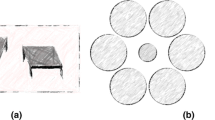Abstract
The traditional sciences have always had trouble with ambiguity. To overcome this barrier, ‘science’ has imposed “enabling constraints”—hidden assumptions which are given the status of ceteris paribus. Such assumptions allow ambiguity to be bracketed away at the expense of transparency. These enabling constraints take the form of uncritically examined presuppositions, which we refer to throughout the article as “uceps.” The meanings of the various uceps are shown via their applicability to the science of climate change. Second order science examines variations in values assumed for these uceps and looks at the resulting impacts on related scientific claims. Second order science reveals hidden issues, problems and assumptions which all too often escape the attention of the practicing scientist (but which can also get in the way of the acceptance of a scientific claim). This article lays out initial foundations for second order science, its ontology, methodology, and implications.




Similar content being viewed by others
References
Achenbach, J. (2015). Many scientific studies can’t be replicated. That’s a problem. The Washington Post (August 27).
Arló-Costa, H., & Helzner, J. (2010). Ambiguity aversion: The explanatory power of indeterminate probabilities. Synthese, 172(1), 37–55.
Ashby, W. R. (1958). Requisite variety and its implications for the control of complex systems. Cybernetica, 1(2), 83–99.
Aufenvenne, P., Egner, H., & von Elverfeldt, K. (2014). On climate change research, the crisis of science and second-order science. Constructivist Foundations, 10(1), 120–129.
Belluz, J. (2015). Scientists replicated 100 recent psychology experiments. More than half of them failed. Vox Science and Health August 27.
Bhattacharjee, J. (2013). The Mind of a Con Man. The New York Times (April 26).
Blake, A. (2015). Americans’ increasing distrust of science—And not just on climate change. Washington Post, January 30.
Bojanowski, A. (2014). Climate change debate: A famous scientist becomes a skeptic. der Spiegel, May 12.
Brown, N. (2014). Cholesterol guidelines: Myth vs. truth—what you need to know. Huffington Post, February 1.
Buchanan, R. (2009). Thinking about design: An historical perspective. In A. Meijers et al. (Eds.) Philosophy of technology and engineering sciences (Handbook of the Philosophy of Science, Book 9) (pp. 409–454). Amsterdam: North Holland.
Derman, E. (2011). Models. Behaving. Badly: Why confusing illusion with reality can lead to disaster, on Wall Street and in life. New York: Free Press.
Dewey, J. (1934). Art as experience. New York: Minton, Balch & Company.
Dinan, S. (2015). Climate change is real and caused by humans, majority of senators believe. Washington Times, January 25.
Dummett, M. (1981). The Interpretation of Frege’s Philosophy. Massachusetts: Harvard University Press.
Empson, W. (1910/1966). Seven types of ambiguity. New York: New Directions.
Ernstene, A. C., et al. (1961). Dietary fat and its relation to heart attacks and strokes. In Report by the Central Committee for Medical and Community Program of the American Heart Association, Circulation, 23.
Fitzgerald, F. S. (1945). The crack-up. New York: New Directions.
Frege, G., 1948 [1892]. Sense and reference. The Philosophical Review, 53, 209–230.
Gooding, D., & Addis, T. (2008). Modelling experiments as mediating models. Foundations of Science, 13, 17–35.
Habermas, J. (1996). Between Facts and Norms: Contributions to a Discourse Theory of Law and Democracy, tr. William Rehg. Cambridge: Polity, MIT Press.
Hawking, S., & Mlodinow, L. (2010). The grand design. New York City: Bantam Books.
Hickman, L., & Randerson, J. (2009). Climate sceptics claim leaked emails are evidence of collusion among scientists. The Guardian (UK). Retrieved 27 July, 2010.
Hugo, V. (2005). The history of a crime. Mondial: Watson Square.
Husserl, E. (1913/1982). Ideas pertaining to a pure phenomenology and to a phenomenological philosophy—First Book: General introduction to a pure phenomenology (F. Kersten, Nijhoff Trans.). Hague: Nijhoff
Keys, A. (1970). Coronary heart disease in seven countries. Circulation, 41(suppl 1), 1–211.
Keys, A. (1980). Seven countries: A multivariate analysis of death and coronary heart disease. Massachusetts: Harvard University Press.
Kromhout, D., et al. (1989). Food consumption patterns in the 1960s in seven countries. American Journal of Clinical Nutrition, 49, 889–894.
Lakatos, I. (1970). Falsification and the methodology of scientific research programmes. In I. Lakatos & A. Musgrave (Eds.), Criticism and the growth of knowledge. Cambridge: Cambridge University Press.
Lawrence, J. (2014). Genes influence response to statins, research finds. The Pharmaceutical Journal. doi:10.1211/PJ.2014.20067031
Lissack, M., & Graber, A. (2014). Modes of explanation: Affordances for action and prediction. Basingstoke: Palgrave Macmillan.
Lupton, D. (2013). Risk. London: Routledge.
Lynas, M. (2015). Even in 2015, the public doesn’t trust scientists. The Washington Post, January 30.
Millner, A., Dietz, S., & Heal, G. (2013). Scientific ambiguity and climate policy. Environmental & Resource Economics, 55(1), 21–46.
Morin, E. (2008). On complexity (Advances in systems theory, complexity, and the human sciences). New York: Hampton Press.
Mueller, K. (2014). Towards a general methodology for second-order science. Systemics, Cybernetics And Informatics, 12(5), 33–42.
Muller, R. (2012). The conversion of a climate-change skeptic. New York Times, July 28.
Nye, A. (1990). Words of power: A feminist reading of the history of logic. London: Routledge.
Open Science Collaboration. (2015). Estimating the reproducibility of psychological science. Science. doi:10.1126/science.aac4716.
Planck, M. (1968). Scientific autobiography and other papers. Greenwood: Westport.
Popper, K. (1959/1974). The logic of scientific discovery. New York: Hutchinson.
Riegler, A., & Mueller, K. (2014). Special issue of on second-order science. Constructivist Foundations, 10(1), 7–15.
Rosen, R. (1985). Anticipatory systems. Oxford: Pergamon press.
Slife, B., & Williams, R. (1995). What’s behind the research: Discovering hidden assumptions in the behavioral sciences. Thousand Oaks: Sage.
Taleb, N. (2007). The Black Swan. London: Penguin.
Umpleby, S. (2014). Second-order science: Logic, strategies, methods. Constructivist Foundations, 10(1), 15–23.
Vaihinger, H. (1924/1911). The philosophy of ‘as if’: A system of the theoretical, practical, and religious fictions of mankind (C. K. Ogden, Trans.). London: Routledge & Kegan Paul.
Whoriskey, P. (2015). The US government is poised to withdraw longstanding warnings about cholesterol. Washington Post, February 10.
Author information
Authors and Affiliations
Corresponding author
Rights and permissions
About this article
Cite this article
Lissack, M. Second Order Science: Examining Hidden Presuppositions in the Practice of Science. Found Sci 22, 557–573 (2017). https://doi.org/10.1007/s10699-016-9483-x
Published:
Issue Date:
DOI: https://doi.org/10.1007/s10699-016-9483-x




